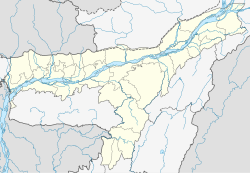Ugratara Devalaya
This article contains weasel words: vague phrasing that often accompanies biased or unverifiable information. (September 2015) |
| Ugratara Devalaya | |
|---|---|
 | |
| Religion | |
| Affiliation | Hinduism |
| District | Kamrup metropolitan district |
| Deity | Ugratara |
| Festivals | Durga puja, Manasa puja |
| Location | |
| Location | Uzan Bazaar |
| State | Assam |
| Country | India |
| Geographic coordinates | 26°10′48″N 91°44′24″E / 26.18000°N 91.74000°E |
| Architecture | |
| Type | Nilachal architecture |
| Creator | Siva Singha |
| Date established | 1725 CE |
Ugratara Devalaya is a temple dedicated to Ugratara located in the western side of Jor Pukhury tanks in the heart of Guwahati city in the Lotaxil (Latasil) locality in Northeast India. The Ugratara Temple in Uzan Bazaar in the eastern part of Guwahati, Assam, is a Shakti shrine. Legend has said that the navel of Sati, first consort of Shiva, is related to this temple. Ugratara in Assam is generally identified with Tiksna-Kanta, Eka-Jata, etc., of the Buddhist pantheon.[1][2]
The present temple of Ugra Tara was built by Ahom King Siva Singha in 1725 CE who had excavated a tank three years before. The tank, known as Jorepukhuri, is situated to the east of the temple. The tank still exists, though the upper section of the temple was destroyed by a devastating earthquake. This was however rebuilt by a local citizen.
Kalika purana describes a Shakti peetha called Dikkara vasini. Dikkara vasini has two forms, Tikshna kantha and Lalitha kantha. Tikshna kantha is black and pot bellied, also called as Ugra Tara or Eka jata. Lalitha kantha is gracefully attractive, also called as Tamreshwari.[3]
In the garbhagriha of Ugra Tara there is no image or idol of her. A small pit filled with water is considered as the Goddess. There is a Shivalaya beside Ugra Tara temple and a pond behind both temples.
Sthala Purana
[edit]Once upon a time, Yama (Lord of the Hell) made a complaint to Brahma that nobody is coming to Hell from Kamarupa because of the sacredness of the area, despite committing sins. Brahma carried this complaint to Vishnu. Vishnu took them to Shiva. Lord Shiva ordered Goddess Ugra Tara to drive away all the people who are living in Kamakhya. She sent her army.
In the course of this drive, they laid their hands on Rishi Vasishtha who was meditating on Shiva at Sandhyachal. Vasishtha became angry and cursed Ugra Tara and Shiva. From then onwards all the Vedic (Shiva) sadhanas are given up in Kama rupa and Ugra Tara became a Goddess of Vamachara sadhana. All her army became Mlechhas.
Sadhana
[edit]Ugra Tara is worshiped in general like Kamakhya. She likes liquor, flesh, Modaka, coconuts, and sugar cane.
References
[edit]- ^ Reflections on the Tantras. S̄udhakar Chattopadhyaya. 1978. p. 76. ISBN 9788120806917.
- ^ The social function of art by Radhakamal Mukerjee. Philosophical Library. 1954. p. 151. ISBN 9780802211682.
- ^ David Gordon White The Alchemical Body: Siddha Traditions in Medieval India, (Kindle Locations 1613–1615). University of Chicago Press. Kindle Edition. "This coastal location reminds us of what may have been Tārā’s original role: she was a goddess of navigation, of sea crossings— tārā is generated from the verb tṛ, to cross over the sea."
26°11′20.81″N 91°45′13.58″E / 26.1891139°N 91.7537722°E
